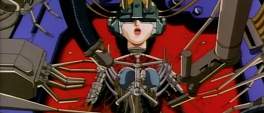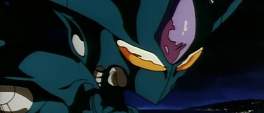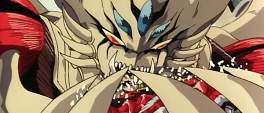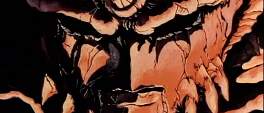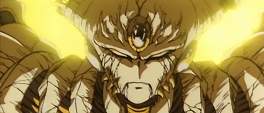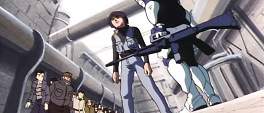Back before I can coherently remember I watched a lot of the anime that made it on to British television. The mid nineties was before DVDs were widely available and the internet was squeezed through telephone lines. I was clueless but took what I could get which at the time was Manga Entertainment's (UK) catalogue of the time. Beyond the obvious Akira and Ghost in the Shell, this consisted mostly of late eighties and early nineties OVAs. Still aeons away from mainstream television, analogue satellite was the only way to watch them. The Sci-Fi channel was just starting out so it was late night on Bravo the majority of these were shown, and it was blind luck if I managed to know they were on prior to airing.
Genocyber was not the first one I saw and certainly not the most memorable, but individual scenes stuck in my head, mostly thanks to my then very squeamish nature. In the interests of exploring both my and anime's past, I decided to rewatch a lot of the shows which, subconsciously at least, formed the foundations for my current viewing preferences.
Genocyber, or to give it its full title: Super Cult Animation Genocyber, Cyber Monster From Imaginary World, is the tale of a cybernetic, psychic monster created by a world-spanning conglomerate at a time when peace was finally beginning to take root in the world. In five episodes it covers the titular Genocyber's birth, its assault on the earth and the long-term aftermath.
The series of episodes can best be described as scattershot. It has everything that characterised the time period from over-the-top gore to a callous disregard for uninvolved bystanders. It was preceded thematically by movies such as The Terminator and Akira and succeeded by series such as Elfen Lied, media where just being in the vicinity of the antagonist is cause for horrific mutilation. The first episode here is double length and is an orgy of violence, viscera and confusion. Ostensibly telling the story of how the superpowered monster was created, it ends up jumping between so many different characters (who die) and locations (which explode) the credits are a welcome respite from the visual and auditory bedlam.
It is undeniably gorgeous for its age though. The ubiquitous monster is gloriously detailed and mixes together biological and technological that has strong echoes of Guyver; even incidental cannon fodder though are given intricate transformation sequences, only to be brutally eviscerated not thirty seconds later. Certainly its not up to the computer aided, silky smooth trickery available today, but it takes on the challenge of detailed monster and creature design with aplomb.
Split into three distinct arcs, the next one takes place on a military super carrier on its way to decimate an unnamed desert nation and thankfully dials down the madness that characterised the first episode. This is good for coherence but exposes how poor the plot really is. Behind the freakishly detailed human dismemberment is a story about a little girl who is at the whims of mad scientists: their hubris creating her and the tools to try and defeat her. This is the central conceit of the show: that mankind is its own worst enemy, but it is told through histrionics and clichés.
There is no subtlety here, it is blunt and obvious, demonstrated most abrasively by the final arc which takes place after a century of mankind battling against Genocyber, when it has long since slipped into slumber. The dregs of society still cling to class wars, ruling by terror and oppression. At this point Genocyber is almost entirely absent from the plot, most of its interaction taking place through dream sequences until the denouement when it awakens, destroying a giant space station which floats menacingly but ineffectually above the earth.
There is obviously a wealth of imagination that has gone into the production of Genocyber but this is hidden behind the borderline schizophrenia when it comes to plotting. Similarly the cyberpunk ethos of the first episode is shed in the others, replacing it first with the well-trodden scientists versus the military scenario, then post-apocalyptic mundanity. It's somewhat surprising to find humanity amidst all of the body parts and tech-fetishism, but the plight of the little girl who only wanted a friend just isn't prevalent enough to redeem the plot, especially with the thoroughly disappointing climax. No wonder Manga Entertainment decided to forgo the final two episodes upon initial release.
Eyes bigger than its budget and a worrying array of deviance on show - exploding humans segues into a vagina's-eye view of childbirth - means that Genocyber is only for the curious. Flashes of inspiration not withstanding, it doesn't advance any of the genres it careens through or provide anything more than a handful of scenes memorable only for their goriness rather than inventiveness.
Where are they now?
Genocyber's director Koichi Ohata took up similar duties on Burst Angel as well as the latter three Ikkitousen series and the most recent installation of You're Under Arrest; Ohata is probably best known though for his mecha design sensibilities shown with genre touchstones such as Gunbuster, SDF Macross II and Dangaioh, all of which preceded his stint as director.
The animation staff is mostly underwhelming but for two exceptions. The first is the use of TAO Corporation Ltd. for animation which was founded by Jan Scott-Frazier who was something of a legend at the time for being one of the only foreigners to work in the, then entirely Japanese, animation industry. The other will be a familiar name as of late, Kenji Kamiyama as art director, moving on from productions such as Burn Up! and Roujin Z, and onto a similar role in Jin-Roh, then coming on as director for the solid Serei no Moribito and the stunning Ghost in the Shell: Standalone Complex and Eden of the East.
The primary production company responsible was Artmic which was dissolved in the late nineties but provided some iconic series for its time including Bubblegum Crisis, Dangaioh and Riding Bean as well as Genesis Climber MOSPEADA which is notable for its ham-fisted inclusion in the western Robotech series. Production was aided by Artland which is still in business and has since provided us with the stellar Mushishi as well as most recently with Ichiban Ushiro no Daimaou.
Contextually Genocyber's impact is hard to place. Capitalising on the bio-tech approach to mecha design that was so neatly cornered by Guyver and the cyberpunk wave that would eventually be dominated by Ghost in the Shell, it sits mostly unknown for the obvious reason that it isn't that brilliant. What it lacks in imagination it makes up for in bombast, over-egging the conceitedness of technology that had already been more deftly done by Katsuhiro Otomo's seminal Akira. It is often bundled together conceptually and commercially with other similarly lacklustre series of the time such as M.D. Geist which also featured Genocyber's director Koichi Ohata in a mecha design role.



